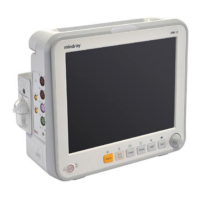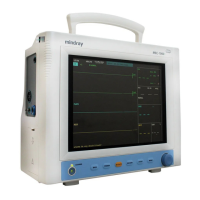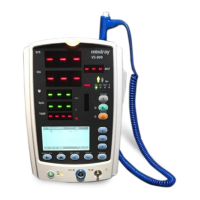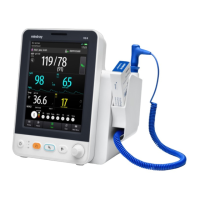11-4
11.5.4 Monitoring SpO
2
and NIBP Simultaneously
When monitoring SpO
2
and NIBP on the same limb simultaneously, you can switch [NIBP
Simul] on in the [SpO
2
Setup] menu to lock the SpO
2
alarm status until the NIBP
measurement ends. If you switch [NIBP Simul] off, low perfusion caused by NIBP
measurement may lead to inaccurate SpO
2
readings and therefore cause false physiological
alarms.
11.5.5 Sat-Seconds Alarm Management
With traditional pulse oximetry alarm management, high and low alarm limits are set for
monitoring oxygen saturation. During monitoring, as soon as a limit is violated, an alarm is
triggered. When the patient % SpO
2
fluctuates near an alarm limit, the alarm sounds each
time the limit is violated. Such frequent alarm can be distracting. Nellcor’s Sat-Seconds
alarm management technique is used to reduce these nuisance alarms.
The Sat-Seconds feature is available with the Nellcor SpO
2
module to decrease the likelihood
of false alarms caused by motion artifacts. To set the Sat-Seconds limit, select [Sat-Seconds]
in the [SpO
2
Setup] menu and then select the appropriate setting.
With Sat-Seconds alarm management, high and low alarm limits are set in the same way as
traditional alarm management. A Sat-Seconds limit is also set. The Sat-Seconds limit controls
the amount of time that SpO
2
saturation may be outside the set limits before an alarm sounds.
The method of calculation is as follows: the number of percentage points that the SpO
2
saturation falls outside the alarm limit is multiplied by the number of seconds that it remains
outside the limit. This can be stated as the equation:
Sat-Seconds= Points × Seconds
Only when the Sat-Seconds limit is reached, the monitor gives a Sat-Seconds alarm. For
example, the figure below demonstrates the alarm response time with a Sat-Seconds limit set
at 50 and a low SpO
2
limit set at 90%. In this example, the patient % SpO
2
drops to 88% (2
points) and remains there for 2 seconds. Then it drops to 86% (4 points) for 3 seconds, and
then to 84% (6 points) for 6 seconds. The resulting Sat-Seconds are:
% SpO
2
Seconds Sat-Seconds
2× 2= 4
4× 3= 12
6× 6= 36
Total Sat-Seconds= 52

